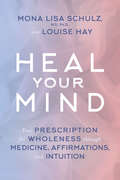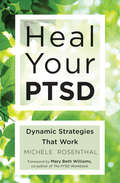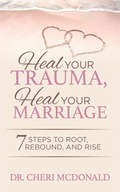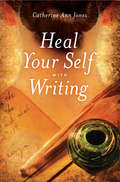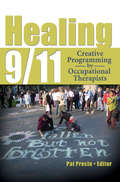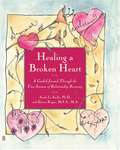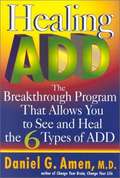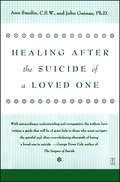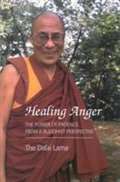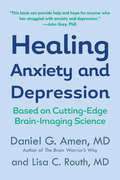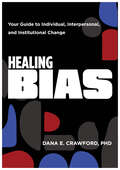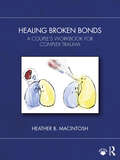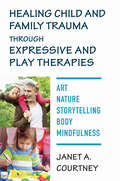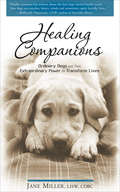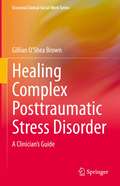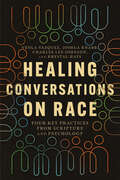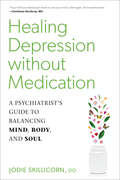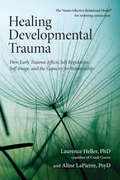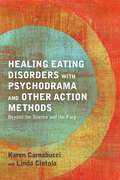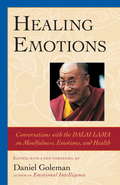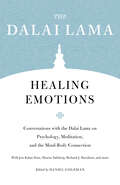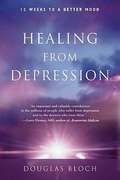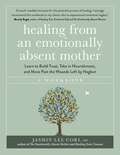- Table View
- List View
Heal Your Mind: Your Prescription For Wholeness Through Medicine, Affirmations, And Intuition
by Mona Lisa Schulz Louise HayMany of us grapple with how to stay happy, calm, and focused in a world that seems to get more complex by the minute. How do we keep our wits about us, our mood stable, and our memory intact when our brains and bodies are bombarded with information and influences from every side? This one-of-a-kind resource combines cutting-edge science with compassion and wisdom to offer answers we can really use.Heal Your Mind continues the three-pronged healing approach that Dr. Mona Lisa Schulz and Louise Hay pioneered together in All Is Well: Heal Your Body with Medicine, Affirmations, and Intuition. Here, it’s applied to aspects of the mind ranging from depression, anxiety, and addiction to memory, learning, and even mystical states. You’ll learn what’s going on in your brain and body when: • You feel sad, angry, or panicked • An addictive substance or behavior has hold of you • You have trouble focusing, reading, or remembering • A past trauma is clouding your mind in the present • An emotional state is a clue to a physical ailment • And moreAnd in each chapter, you’ll get a "virtual healing experience" through case studies in the All Is Well Clinic, where Dr. Mona Lisa uses medical intuition to pinpoint issues in a wide range of prototypical client histories and she and Louise offer solutions and affirmations to help restore well-being.Today, the "pill-for-every-ill" approach is so prevalent that we may think our minds and bodies need an endless array of expensive, ever-changing pharmaceutical interventions. In truth, medicines are just one approach to healing the mind; nutritional supplements give us another important way to support mind-body health; and affirmations, as well as various forms of therapy, can restore us to balance by changing the way we think. Heal Your Mind puts all these tools at your disposal to help you choose your own path toward wholeness.
Heal Your PTSD: Dynamic Strategies That Work
by Michele RosenthalSelf-help measures to supplement PTSD recovery: &“Excellent.&”—Mary Beth Williams, PhD, MCSW, co-author of The PTSD Workbook Following a critical illness, Michele Rosenthal struggled with Post-Traumatic Stress Disorder for twenty-five years. Now a post-trauma coach and award-winning writer, Rosenthal shares the program that helped her and others. Trauma and recovery have never been easy, and with different trauma disorders, there is no one solution. Whether it&’s psychological trauma or emotional trauma, by exerting self and emotional control, readers can examine how, when, and in what way to move toward recovery. Find stages and exercises to build a flexible, unique system that strengthens trauma recovery. Inside, learn how to: · Connect to your own power and authentic self · Apply self-help measures like mindfulness and meditation · Handle trauma symptoms and recovery obstacles
Heal Your Trauma, Heal Your Marriage: 7 Steps to Root, Rebound, and Rise
by Dr. Cheri McDonaldHeal Your Trauma, Heal Your Marriage is a roadmap for women to conquer the rippling effects of complex trauma on themselves and their marriage.For over thirty years, Dr. Cheri McDonald has helped her clients achieve the life of their dreams and a happily-ever-after marriage. By integrating rituals and symbolic steps to her teamwork-based approach, Dr. Cheri guides women within Heal Your Trauma, Heal Your Marriage on how to:Awaken to their amazing truth and dream-come-true marriageRenew their fractured heart with re-ignited, passionate energy for everlasting healing from the inside outRevive their voice to victoriously express their deepest desiresRestore their power to intuitively learn how to be present in their marriageRise to forgiveness for themselves and their partner
Heal Yourself With Writing
by Catherine Ann JonesOur lives may be determined less by past events than by the way we remember them. How do we learn to listen more to the stories that heal? How do we put together the pieces of our past? How can we rewrite our life story so that pain becomes meaningful and actually promotes growth and transformation? Heal Your Self with Writing offers a step-by-step journey of discovery and re-visioning through focused journaling, a practice that can enable healing and empowerment. In this way, each reader is able to make meaning out of memory and put the past where it belongs - behind them.
Healing 9/11: Creative Programming by Occupational Therapists
by Pat PrecinGet a first-hand look at the ongoing tragedy of 9/11 Healing 9/11 examines programs and interventions created and implemented by occupational therapists to aid those affected directly-and indirectly-by the 9/11 attacks. Ideal for courses in trauma and recovery, community interventions, disaster recovery, health programs and implementation, and mental health interventions as well as for professionals, this powerful book chronicles the experiences of OTs who worked with firefighters, burn victims, and displaced workers, as well as children, students, and clients suffering long-term symptoms of depression and anxiety. These first-hand accounts offer rare insights into the healing process for victims of terrorism (including OTs themselves), and serve as a guide to developing outreach and counseling services to those touched by future incidents. Healing 9/11 continues the work of Surviving 9/11: Impact and Experiences of Occupational Therapy Practitioners (Haworth), presenting detailed personal and professional accounts from OTs who provided physical, emotional, and psychosocial relief to thousands of disaster victims. This unique book reveals how OTs provided aggressive manual therapy, wound care, and scar management to the critically injured; how OTs analyzed the job market and found work for people who had lost their livelihoods; how OTs worked with students in classroom settings to relieve their anxieties; and how OTs helped rescue workers at Ground Zero deal with the emotions that threatened to overpower them.Healing 9/11 examines: nontraditional group therapy non-clinical treatment settings burn rehabilitation pediatric occupational therapy school-based occupational therapy employment planning occupational frame of reference creative arts therapy post traumatic stress disorder and much more Healing 911: Creative Programming by Occupational Therapists is an essential resource for all healthcare professionals who offer relief in times of disaster.
Healing A Broken Heart
by Sarah La Saulle Sharon KaganThe loss of a love is a nearly universal emotional crisis, whether the end is divorce, desertion, or a mutually agreed-upon separation. At first, friends and family are there to offer a shoulder to cry on, but after a few months there's an expectation that we just need to get over the crisis and move on. Thus, unprocessed, painful feelings are buried, leaving us numb. Or we repeat damaging relationship patterns over and over again. The situation doesn't have to be like that. Healing a Broken Heart guides those of us grieving for a lost love through four metaphorical seasons of recovery with provocative questions -- and journal pages on which to respond -- to help move us forward. The four seasons serve as powerful metaphors for the stages of the grieving process. Summer is the season for charting the course of a relationship: remembering hopes and expectations, the warning signs that went unheeded. During autumn, journalers accept the reality of breaking up and acknowledge things about the relationship that didn't serve their needs. Winter brings the pain of grief over the profound loss. Finally, spring -- and, with it, renewal -- invites readers to examine and understand how their family history may have affected their past relationships. Punctuated throughout with poems and moving meditations, the thoughtful, interactive approach of this book offers the time and space we all need to heal when our hearts are broken.
Healing ADD Revised Edition
by Daniel G. AmenAll-New Revised Edition Attention deficit disorder (ADD) is a national health crisis that continues to grow--yet it remains one of the most misunderstood and incorrectly treated illnesses today. Neuropsychiatrist Daniel G. Amen, MD was one of the first to identify that there are multiple types beyond just purely hyperactive or inattentive ADD, each requiring a different treatment. Now, in this all-new, revised edition, Dr. Amen again employs the latest medical advances in the field, including the largest brain imaging study ever completed on patients with ADD, to identify, examine, and demystify the 7 distinct types of ADD and their specific treatments. With updated recommendations for nutraceuticals and/or medications targeted to brain type, diet, exercise, lifestyle interventions, cognitive reprogramming, parenting and educational strategies, neurofeedback, and more, Dr. Amen's revolutionary approach provides a treatment program that can lead sufferers of ADD to a normal, peaceful, and fully functional life. Sufferers from ADD often say, "The harder I try, the worse it gets." Dr. Amen tells them, for the first time, why, and more importantly how to heal ADD. See Dr. Amen's Public Television Special on ADD!
Healing ADD: The Breakthrough Program That Allows You to See and Heal the Six Types of Attention Deficit Disorder
by Daniel G. AmenA radically new approach to treating the single most common learning and behavioral problem in America. Commonly perceived as a flavor-of-the-month diagnosis, ADD is, in fact, an enormous health problem that will only continue to grow. It affects fully 6 percent of the population, yet less than one-third of them are taking medication. Why? According to Dr. Daniel Amen, Attention Deficit Disorder is underdiagnosed, incorrectly treated, and poorly understood. Dr. Amen, board-certified in child, adolescent, and adult psychiatry and nuclear medicine, has discovered that there are six types of ADD-not just the commonly known two. Moreover, the most frequently prescribed treatment-Ritalin-makes four of these types worse. Dr. Amen's discovery results from an intensive, years-long study of brain imaging that identified the distinctive brain dysfunctions characterizing each ADD type. Giving guidelines and diagnostic tools for determining which type of ADD an adult or child has, Healing ADD from the Inside Out provides readers with a comprehensive and proven program for enhancing the brain function for each of the six types of Attention Deficit Disorder. Encompassing medications, diet, supplements, exercise, and social support, this is the state of the art in ADD treatment. ADD sufferers often say, "The harder I try, the worse it gets." Dr. Amen tells them how to-for the first time-get well. To listen to an interview with Dr. Daniel Amen, check out www.TalktoTara.com
Healing After the Suicide of a Loved One
by John Guinan Ann SmolinHelps family and friends work through grief following a suicide.
Healing After the Suicide of a Loved One
by Ann SmolinToo often people suffering the aftermath of a suicide suffer alone. As the survivor of a person who has ended his or her own life, you are left a painful legacy -- and not one that you chose. Healing After the Suicide of a Loved One will help you take the first steps toward healing. While each individual becomes a suicide survivor in his or her own way, there are predictable phases of pain that most survivors experience sooner or later, from the grief and depression of mourning to guilt, rage, and despair over what you have lost. You may be torturing yourself with repetitive questions such as "What if...?" "Why didn't we...?" and "Why, why, why?" Healing After the Suicide of a Loved One will steer you away from this all-too-common tendency to blame yourself and will put you on the path to healing and recovery. Remember, your wounds can heal and you can recover. Filled with case studies, excellent information, valuable advice, and a completely up-to-date reading list and directory of suicide support groups nationwide, this valuable book will give you the strength and hope to go on living.
Healing Anger: The Power of Patience from a Buddhist Perspective
by Dalai Lama Geshe Thupten JinpaThe Dalai Lama teaches with clear and forceful language. These teachings form an essential spiritual discourse. When we get angry with someone we are often unaware of the effect it has on that person, let alone the ripple effect it causes. Nonetheless, it does indeed have a ripple effect: that person does not hang on to the anger but passes it on, perhaps repeatedly. The antidote to anger is patience, and so the dissemination of Shantideva's wisdom regarding patience becomes a critical need in these times.
Healing Anxiety and Depression: The Revolutionary Brain Based Program That Allows You To See
by Daniel G. Amen Lisa C. RouthBased on brain-imaging science, Healing Anxiety and Depression reveals the major anxiety and depression centers of the brain, offers tools to determine the specific type of disorder, and provides a comprehensive program for treating both anxiety and depression. <P><P>Dr. Daniel Amen—a pioneer in uncovering the connections between the brain and behavior—presents his revolutionary approach to treating anxiety and depressive disorders. Based on brain science—and featuring treatment plans that include medication, diet, supplements, exercise, and social and therapeutic support—this groundbreaking book will help you conquer these potentially devastating disorders and change the way you think about anxiety and depression. <P><P>Healing Anxiety and Depression: • Reveals 7 types of anxiety and depression • Provides proven-effective treatment plans for each type • Explains the source of anxiety and depression through brain images • Includes a self-diagnostic type-determining test
Healing Bias: Your Guide to Individual, Interpersonal, and Institutional Change
by Dana E. CrawfordBlends CBT and interpersonal therapy principles for implementable actions to reduce bias. Everyone has biases, yet most people are unable to discuss them openly without feelings of shame, stigma, and defensiveness. Although perceived as flaws or a question of one’s character, these biases should be viewed as socially constructed coping mechanisms shaped by trauma, stress, and the need to survive. Only when redefined will we be able to have honest conversations about and reductions in bias, race, and prejudice. Dana Crawford’s Crawford Bias Reduction Theory & Training (CBRT) invites readers on a transformative journey to understand, research, and reduce bias at the internal, relational, and systemic levels. Her three-pronged approach starts with the awareness phase which focuses on self-reflection and group interaction through empathy, compassion, and accountability. The investigation phase will help readers recognize and dissect bias within themselves, with others, and in society. Lastly, the reduction phase further develops skills to confront and mitigate bias with exercises like role-play and real-play scenarios. With reflection prompts, personal stories, actionable advice, and examples inspired by actual events, Healing Bias translates complex ideas into relatable, empowering solutions that can be used on your own or in group settings. This guide can be used with the Racial Awareness Conversations for Everyone (R. A. C. E.) card deck to enhance self-reflection and group discussion with questions based on the CBRT model.
Healing Broken Bonds: A Couple's Workbook for Complex Trauma
by Heather B. MacIntoshThis one-of-a-kind theoretical and practical workbook provides couples with tools to work towards healing their relationships and experiences of trauma. It will be an invaluable resource for mental health professionals working with trauma survivors and those who are using Developmental Couple Therapy for Complex Trauma (DCTCT) with the couples they work with.Serving as a self-help guide for couples as well as a companion to Developmental Couple Therapy for Complex Trauma: A Manual for Therapists, this workbook provides couples with accessible exercises they can work with on their own and for clinicians to share with their clients to support their therapy work. Chapters cover psychoeducation, skills building, attachment focused dyadic processing, and consolidation so couples can bring these new skills and insights into daily life. Featuring downloadable handouts and journal reflections, as well as questions and discussion prompts throughout, the author holds in mind the varied backgrounds that patients come from, such as their cultural, ethnic, community, sexual and gender identities, and socio-economic group, and integrates these diverse needs into the exercises, thus providing inclusivity within the treatment process. The book is essential reading for trauma survivor couples and individuals looking to build stronger and healthier relationships, as well as couple and family therapists, counsellors, and other mental health professionals who help clients navigate experiences of trauma.
Healing Child and Family Trauma through Expressive and Play Therapies: Art, Nature, Storytelling, Body And Mindfulness
by Janet A. Courtney PhD, RPT-SHealing assessments and interventions from disparate areas of knowledge such as art, nature, and storytelling. There are many ways to help children and families heal from trauma. Leaning on our ancestral wisdom of healing through play, art, nature, storytelling, body, touch, imagination, and mindfulness practice, Janet A. Courtney helps the clinician bring a variety of practices into the therapy room. This book identifies seven stages of therapy that provide a framework for working with client’s emotional, cognitive, somatic, and sensory experiences to heal from trauma. Through composite case illustrations, practitioners will learn how to safely mitigate a range of trauma content, including complicated grief, natural disaster, children in foster care, aggression, toxic divorce, traumatized infants diagnosed with neonatal abstinence syndrome, and young mothers recovering from opioid addiction. Practice exercises interspersed throughout guide practitioners to personally engage in the creative expressive and play therapy techniques presented in each chapter, augmenting professional self- awareness and skill- building competencies.
Healing Companions: Ordinary Dogs and Their Extraordinary Power to Transform Lives
by Jane Miller&“Finally, someone has written about the best kept mental health secret: how dogs save psyches, hearts, minds, and sometimes, quite literally, lives . . .&”—Belleruth Naparstek, LISW, author of Invisible Heroes As the more than 65 million dog-owners in America will attest, there&’s something about the presence of a dog that inspires confidence, nurtures emotional well-being, and brings out the best in ourselves. But for some people, the presence of a dog can do even more. Written by the leading expert in an emerging new field of therapy, Healing Companions is the first book to detail how dogs are increasingly benefiting those who suffer from a range of emotional ills, from eating disorders and anxiety, to agoraphobia, depression, and post-traumatic stress. Healing Companions will teach you: What criteria to consider when choosing the right dog for you.What kind of training service dogs require.What to expect and how to respond when you take a service dog out in public.How a dog can complement other forms of therapy.How to navigate the procedural regulations that apply to a service dog.How to recognize the dog&’s needs and provide it with proper care.And much more. &“Animals are more complete than people. They are wonderful teachers, therapists and role models for us all. Read Healing Companions and learn about their ability to guide and heal us all.&”—Bernie Siegel, MD, #1 New York Times bestselling author of Love, Animals, and Miracles &“This book should be required reading for everybody who is considering getting a psychiatric service dog or is working on training them.&”—Temple Grandin, author of Animals Make Us Human
Healing Complex Posttraumatic Stress Disorder: A Clinician's Guide (Essential Clinical Social Work Series)
by Gillian O’Shea BrownThis book is a clinician's guide to understanding, diagnosing, treating, and healing complex posttraumatic stress disorder (C-PTSD). C-PTSD, a diagnostic entity to be included in ICD-11 in 2022, denotes a severe form of posttraumatic stress disorder (PTSD) and is the result of prolonged and repeated interpersonal trauma. The author provides guidance on healing complex trauma through phase-oriented, multimodal, and skill-focused treatment approaches, with a core emphasis on symptom relief and functional improvement. Readers will gain familiarity with the integrative healing techniques and modalities that are currently being utilized as evidence-based treatments, including innovative multi-sensory treatments for trauma, in addition to learning more about posttraumatic growth and resilience. Each chapter of this guide navigates readers through the complicated field of treating and healing complex trauma, including how to work with clients also impacted by the shared collective trauma of COVID-19, and is illustrated by case examples. Topics explored include:Complex layered traumaDissociationTrauma and the bodyThe power of beliefAn overview of psychotherapy modalities for the treatment of complex traumaEgo state work and connecting with the inner childTurning wounds into wisdom: resilience and posttraumatic growthVicarious trauma and professional self-care for the trauma clinicianIt is important for clinicians to be aware of contemporary trends in treating C-PTSD. Healing Complex Posttraumatic Stress Disorder is an essential text for mental health practitioners, clinical social workers, and other clinicians; academics; and graduate students, in addition to other professionals and students interested in C-PTSD. It is an attractive resource for an international clinical audience as we work together to heal, affirm, and unburden clients following this time of shared collective trauma.
Healing Conversations on Race: Four Key Practices from Scripture and Psychology
by Veola Vazquez Joshua Knabb Charles Lee-Johnson Krystal HaysRace complicates our relationships, even when we reject racism and seek to walk a better path together. How can we get our thinking—and our conversations—unstuck from entrenched patterns? In this book, four experts in psychology and social work present a model for how to build and deepen the cross-race relationships we want. The starting place, they testify, must be a biblical understanding of the problem of racial disunity, grounded in the grand narrative of Scripture, followed by practical insights about psychology and social behavior. This book is the culmination of professional—but also deeply personal—conversations the authors have had with each other, wrestling together over current events, their own stories, and their roles in the healing process. They combine biblical teachings with psychological science to help Christians develop the skills to discuss race and ethnicity. In each chapter, you will be guided through essential information, biblical examples, case studies, activities, and journaling exercises to prepare you to practice healing conversations. Using research from psychology, attachment theory, and emotionally focused therapy, this process will build your knowledge, self-awareness, other-awareness, and specific relational skills. Jesus embodied love, challenged injustice, welcomed those rejected by society, and engaged in healing conversations with everyone he encountered. The insights and practices in Healing Conversations on Race will help Christians grow in Christlikeness and follow his example.
Healing Depression without Medication: A Psychiatrist's Guide to Balancing Mind, Body, and Soul
by Jodie SkillicornWhat if everything we thought we knew about depression—and how to heal from it—was wrong? Many antidepressants—the first line in our standard of care for treating depression—bring with them potential health risks, yet 1 in 6 Americans takes medication to alleviate feeling sad, anxious, stuck, or unable to focus or sleep. More and more, conventional medicine pathologizes how we respond to life&’s challenges—like feeling trapped in an unfulfilling job, grieving the death of a loved one, or being anxious about a bad relationship—telling us that they&’re symptoms of disease. Psychiatrist Jodie Skillicorn presents a new path, debunking the myth of the neurochemical imbalance and exploring the roots of depression, such as adverse childhood experiences (ACEs) and poorly managed day-to-day stress. Evidence-based and fully supported by current depression research, Dr. Skillicorn&’s holistic methods for beating depression—including nutrition, mindfulness, fostering meaningful connections, exercise, sleep, nature, and breathwork—empower readers to become agents of their own wholeness and healing.
Healing Developmental Trauma
by Aline Lapierre Laurence HellerWritten for those working to heal developmental trauma and seeking new tools for self-awareness and growth, this book focuses on conflicts surrounding the capacity for connection. Explaining that an impaired capacity for connection to self and to others and the ensuing diminished aliveness are the hidden dimensions that underlie most psychological and many physiological problems, clinicians Laurence Heller and Aline LaPierre introduce the NeuroAffective Relational Model® (NARM), a unified approach to developmental, attachment, and shock trauma that, while not ignoring a person's past, emphasizes working in the present moment. NARM is a somatically based psychotherapy that helps bring into awareness the parts of self that are disorganized and dysfunctional without making the regressed, dysfunctional elements the primary theme of the therapy. It emphasizes a person's strengths, capacities, resources, and resiliency and is a powerful tool for working with both nervous system regulation and distortions of identity such as low self-esteem, shame, and chronic self-judgment.From the Trade Paperback edition.
Healing Eating Disorders with Psychodrama and Other Action Methods: Beyond the Silence and the Fury
by Karen Carnabucci Linda CiotolaPsychodrama and other action methods are especially helpful in the treatment of the classic eating disorders as well as dieting struggles, body dissatisfaction and associated issues of fear, sadness, silence and shame. This book provides clinicians with sound theoretical information, practical treatment guidelines and a wealth of clinically-tested action structures and interventions. The authors describe how they have introduced action methods to work with a diverse range of clients, and suggest ways in which psychodrama practitioners, experiential therapists and others may integrate these methods into their practice. Offering fresh ideas for tailoring psychodramatic standards such as The Living Newspaper, Magic Shop and the Social Atom to eating disorder issues, they provide extensive examples of psychodrama interventions - classic and specially adapted for eating disorders - for both the experienced practitioner and those new to experiential therapies. They also explain how psychodrama can be used in combination with other expressive, holistic and complementary approaches, including family constellations, music, art, imagery, ritual, Five Element Acupuncture, yoga, Reiki and other energy work. This pioneering book is essential reading for practitioners and students of psychodrama, drama therapy, experiential psychotherapy, cognitive and expressive arts therapies and mental health professionals, as well as professionals interested in complementary health modalities.
Healing Emotions: Conversations with the Dalai Lama on Mindfulness, Emotions, and Health
by Daniel GolemanCan the mind heal the body? The Buddhist tradition says yes—and now many Western scientists are beginning to agree. Healing Emotions is the record of an extraordinary series of encounters between the Dalai Lama and prominent Western psychologists, physicians, and meditation teachers that sheds new light on the mind-body connection. Topics include: compassion as medicine; the nature of consciousness; self-esteem; and the meeting points of mind, body, and spirit. This edition contains a new foreword by the editor.
Healing Emotions: Conversations with the Dalai Lama on Psychology, Meditation, and the Mind-Body Connection (Core Teachings of Dalai Lama)
by The Dalai LamaHealing Emotions is the record of an extraordinary series of encounters between the Dalai Lama and prominent Western psychologists, physicians, and meditation teachers that sheds new light on the mind-body connection. Edited by Pulitzer Prize nominee and best-selling author Daniel Goleman.Can the mind heal the body? The Buddhist tradition says yes--and now many Western scientists are beginning to agree. These discussions between the Dalai Lama and this group of prominent physicians, psychologists, philosophers, and behaviorists could not be more timely. The book is a record of the third Mind and Life Conference, a meeting that took place in Dharamsala, India, gathering Buddhist teachers and Western scholars to discuss questions that provide a framework for an ongoing dialogue between psychology and Buddhism. Edited with a new foreword by Daniel Goleman, this exploration of stress, death, meditation, self-compassion, and much more underscores the timeliness and significance of working together--across scientific and religious aisles--for the greater benefit of humankind.
Healing From Depression: 12 Weeks To A Better Mood
by Douglas Bloch Robert Allen BartlettIn Healing from Depression, Douglas Bloch shares his struggle to stay alive amidst overwhelming despair and out-of-control anxiety attacks, and explains how the power of prayer and other holistic approaches ultimately led to his recovery. As one of the millions of Americans who suffer from depression, Bloch could not be helped by so-called “miracle” drugs. Therefore, he had to seek out conventional and alternative non-drug methods of healing. The result is a 12-week program that combines his inspirational story with a comprehensive manual on how to diagnose and treat depression, offering new hope and practical strategies to everyone who suffers from this debilitating condition. Complete with worksheets and goal sheets to customize individual plans, Healing from Depression is an accessible self-guided program for managing and recovering from depression. Acclaimed as a “life-line to healing,” this important book stresses the importance of social support, on going self-care activities like relaxation, nutrition, exercise, prayer, meditation, support groups, therapy and keeping a daily mood diary and gratitude journal.
Healing From an Emotionally Absent Mother: Learn to Build Trust, Take In Nourishment and Move Past the Wounds Left by Neglect – A Workbook
by Jasmin Lee CoriA new workbook to accompany the ground-breaking guide to self-healing and getting the love you missed.⭐⭐⭐⭐⭐ OVER 2000 5-STAR REVIEWS FOR THE EMOTIONALLY ABSENT MOTHER ⭐⭐⭐⭐⭐Distant, emotionally neglectful parenting creates wounds that follow children well into adulthood. As you deal with the impacts as an adult, you might find yourself wondering, Why do I fly into reactive feelings so easily? Why is it so hard to attend to my own needs? Why is it hard for me to trust people to be there for me? Do I need to hide parts of myself to be lovable?If you're searching for a way to let go of the pain caused by insufficient mothering, learn to provide yourself with the love you didn't get as a child, and live a more nourished and fulfilled life, Healing from an Emotionally Absent Mother can help. Distilling key takeaways from the groundbreaking book The Emotionally Absent Mother and offering new insights into the legacy left by emotional neglect, this workbook is designed to guide healing with accessible lessons as you: Uncover your childhood experience of emotional neglect Identify the ongoing impacts of this neglect Reclaim the pieces of yourself you changed or hid for Mother's sake Reparent your young self Take advantage of the healing resources available to you Learn to accept the love others offer youPersonal inventories, journaling prompts, small-group discussion questions, and many more hands-on exercises will help you identify the needs that went unmet during childhood and move past the hurt.
